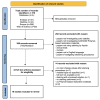Color Stability of Polymer-Based Composite CAD/CAM Blocks: A Systematic Review
- PMID: 36679343
- PMCID: PMC9865673
- DOI: 10.3390/polym15020464
Color Stability of Polymer-Based Composite CAD/CAM Blocks: A Systematic Review
Abstract
Background: This systematic review aims to evaluate the color stability of resin composite CAD/CAM blocks (CCB) when submitted to staining solutions.
Methods: A systematic search was performed on different databases (Embase, Medline, Scopus, Web of Science). Search terms were: 'polymer infiltrated', 'polymer-based', 'resin nanoceramic', 'resin ceramic', 'hybrid composite', 'hybrid ceramic', 'composite ceramic', 'resin infiltrated', 'CAD-CAM', 'CAD/CAM', 'color stability', 'staining', 'staining susceptibility', 'color change', 'color difference'.
Inclusion criteria: in vitro articles published in the English language until 18 September 2022 without initial time restriction evaluating the color stability of CCB when submitted to staining solutions.
Exclusion criteria: studies investigating color change induced by smoke or whitening treatments; studies not including a clinical evaluation of the results using the thresholds for color perceptibility and acceptability. Risk of bias assessment using the QUIN tool.
Findings: Out of the 378 initially retrieved articles, 19 were included in this review. They investigated 17 different CCBs and different artificial staining by liquid protocols, including coffee, red wine, tea, and cola. CCBs exceeded clinical acceptability thresholds for color shift in 18 out of 19 studies, with a significantly higher color stability than conventional hybrid resin-based composites (RBCs), and a significantly lower color stability than ceramic materials. The identified differences in CCBs in color stability can be attributed to the material's composition, but also to the heterogeneity of staining procedures. Interpretation and clinical implication: Clinicians should be aware that, although to a lower degree when compared to RBCs used in direct or indirect procedures, CCBs undergo color changes to a higher degree in comparison to ceramic materials.
Keywords: cad/cam; color change; color stability; composite; hybrid ceramic; polymer-based; resin ceramic; resin nano-ceramic; staining.
Conflict of interest statement
The authors declare no conflict of interest.
Figures
References
-
- Mörmann W.H., Brandestini M., Lutz F., Barbakow F. Chairside Computer-Aided Direct Ceramic Inlays. Quintessence Int. 1989;20:329–339. - PubMed
-
- Baldi A., Comba A., Tempesta R.M., Carossa M., Pereira G.K.R., Valandro L.F., Paolone G., Vichi A., Goracci C., Scotti N. External Marginal Gap Variation and Residual Fracture Resistance of Composite and Lithium-Silicate CAD/CAM Overlays after Cyclic Fatigue over Endodontically-Treated Molars. Polymers. 2021;13:3002. doi: 10.3390/polym13173002. - DOI - PMC - PubMed
-
- Baldi A., Comba A., Ferrero G., Italia E., Michelotto Tempesta R., Paolone G., Mazzoni A., Breschi L., Scotti N. External Gap Progression after Cyclic Fatigue of Adhesive Overlays and Crowns Made with High Translucency Zirconia or Lithium Silicate. J. Esthet. Restor. Dent. 2022;34:557–564. doi: 10.1111/jerd.12837. - DOI - PMC - PubMed
Publication types
LinkOut - more resources
Full Text Sources
Miscellaneous


